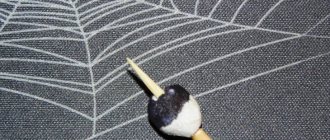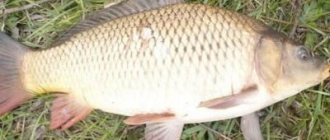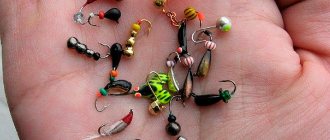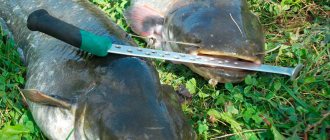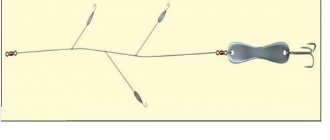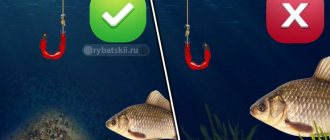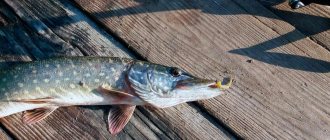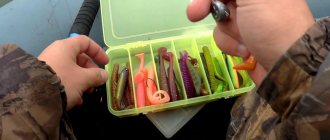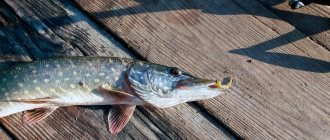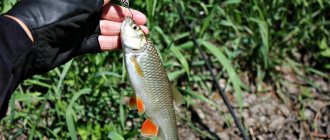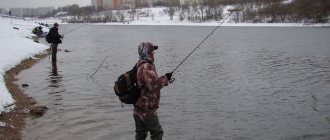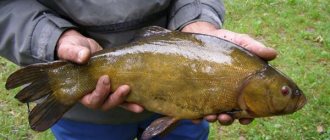Features and advantages of fishing in frost
Snow outside the window is not a reason to leave your spinning rod until spring, pick up a winter fishing rod and jig and go out on the ice. If you don’t live in the north of Siberia, then you have access to a river that remains ice-free for more than 10 months - this is an excellent place for catching predators with a spinning rod. There are many differences between hunting predatory fish in the warm season and in the cold:
- in cold weather the fish is less active - it is easier to detect and stands in one place for a long time, but due to passivity it shows less interest in baits;
- the absence of algae allows you to cast gear in reservoirs with abundant aquatic vegetation in the warm season;
- no insects bother you;
- the catch stays fresh for a long time;
- tranquility - no noise from swimmers and vacationers, no traffic jams;
- the average weight of fish caught in winter is greater than in summer;
- when fishing on the banks of a river without ice, the possibility of failure is excluded;
- there are no competitors and unofficial competitions to see who can catch the most - fishing is a pleasure;
- the ability to fish on rivers where ice does not form.
The disadvantages are obvious:
- low activity of aquatic inhabitants;
- in winter, some of the fish from rivers go into bodies of water with stagnant water - lakes, backwaters;
- your hands get cold and your gear freezes;
- When there is heavy snowfall, it is difficult to get to the fishing spots.
Weather
Fish can be caught in any weather, taking into account the behavior of different species of aquatic inhabitants: some catch better on warm winter days, others are more active in bitter cold. Other aspects have little effect on luck and relate to personal comfort: the wind will not allow you to make normal casts, the low temperature will quickly cover the gear with an ice crust, your hands will freeze, and heavy clothing will hinder your movement.
Note! With frequent trips to several bodies of water at different times, you will begin to notice a number of features and patterns on which the bite of certain fish in the area depends.
Fishing spots
All bodies of water where tackle is thrown are suitable for winter fishing with spinning rods. At the beginning of winter there are a lot of them, by the middle there are places near hydroelectric power stations and industrial production, large rivers (about 100 or more meters wide) with fast currents.
Winter spinning for perch
In winter, fish try to stay at depth, so you should look for it in holes and on their edges. To do this, you need information about the bottom topography. It is not necessary to explore it on a boat with an echo sounder; you can use the experience of others or do the research yourself. Do not try to find prey at a depth shallower than 2.5-3 m. Many fish stay in the winter at the edge, where the current is weaker, near trees, bushes and remnants of vegetation. Only an echo sounder will allow you to identify all the nuances of the bottom structure.
In warm weather and thaws, shallow water with remnants of algae and snags become a feeding ground for peaceful fish, where pike and other predators come out to hunt.
Lures
The main method of fishing in winter is jig. Many anglers like foam fish; they are not as mobile as silicone baits and look like real winter fry. They also catch with silicone, the only condition for all baits is that they must be carried out slowly. When retrieving slowly with long stops, the fish will not have to speed up and catch up with the bait. She will slowly catch up and take it. In the absence of vegetation, you can carry out along the bottom. If you lower the twister or vibrating tail to the bottom, you need to drag it slowly along the bottom with stops. You can try the classic step retrieve, or slow retrieve above the bottom surface. Silicone baits and foam rubber fish are selected in small sizes; a 5-7 cm bait will seduce fish of any size.
Read! Tips for catching large roach in winter
In recent years, fishing with spinning rods in winter has been gaining popularity; you don’t have to sit on the ice; you can fish with spinning rods all year round.
Tackle
It’s easy to equip a winter spinning rod with your own hands. Be responsible when choosing a fishing rod and its equipment, because the properties of polymers change at low temperatures. Another thing is that there is no information on the temperature conditions of their operation on the gear, packaging and labels.
Rod
Budget fishing rods should be avoided; they don’t perform their best in summer either. Even 2 decades ago, carbon fiber rods quickly broke in frost of a couple of degrees, and sometimes even fell apart into components. The best option is a carbon fiber spinning rod.
Pay attention to the correspondence of the test characteristics of the fishing rod to the weight of the bait or, conversely, choose the latter correctly. If any of the experienced fishermen has several spinning rods, they take the one that is suitable for the bait that is more effective in the pond. It is determined empirically.
The length of the spinning rod for winter fishing is selected individually, based on the conditions and skill of the fisherman. For large rivers, you can opt for a longer option - 3 m or more with a fast action. The ability to send bait far from the shore is invaluable for the outcome of the hunt for a river predator.
On small reservoirs and small rivers (conditionally up to 60-70 m wide), a spinning rod 2.5-2.7 m long with a rigid action is sufficient. The weight of the bait should fall within the test characteristic, preferably closer to its top. Usually it ranges from 5-7 to 20-28 g. For small rivers a couple of tens of meters wide, a rod 2.1-2.3 m long will suffice. A long spinning rod in such conditions will allow you to search for fish along the coastline.
The diameter of the rings is at least 7 mm. In cold weather it will quickly decrease due to ice. A warm reel seat is desirable - covered with cork, other wood or foam rubber. This is done with your own hands by wrapping it with fabric or synthetic material, which is secured, for example, with rubber bands.
Coil
The spinning rod can be equipped with any reel you like. The weak point of multiplier versions is the needle bearing. In cold weather, it can jam, and to avoid this situation, the rollers should be periodically lubricated, preferably with a special lubricant, which is sold in fishing stores. The second feature of the reel is its cold, predominantly metal body, the third is that the spool sprays droplets of water that freeze on clothes and hands.
Spinning reel
Attention! The bearing is packed with maximum lubricant to expand the temperature range at which the device can be used. By removing some of the excess grease, you will slightly reduce the smoothness of operation, but the operating temperature will drop by several degrees.
The ideal solution for winter fishing is a spinning reel with 4-5 bearings; for medium and large rivers, pay attention to a power reel. It should lay the line evenly on the spool (cylindrical profile). Any gaps that appear are often eliminated using shims. In the cold, the friction brake of an inertialess reel may act up and cannot be adjusted accurately.
For your information! The desired spool volume for winter spinning is 150 m. Practice has shown that 150 m of braid on a spool will last at least 250% longer than 100 m.
fishing line
Most fishermen agree that multifilament fishing line is better for winter use than monofilament fishing line. Without treatment, it freezes more, but has zero elasticity. Japanese cords made of high molecular weight polymers have a very low coefficient of friction, which has a positive effect on:
- casting range and accuracy;
- wear resistance.
Pay attention to tensile strength, because the nominal diameter does not always correspond to the real one.
Lure or Bait
Winter spinning is not complete without jig baits. Small silicone fish have proven themselves. They are slowly moved along the bottom, submerged, and then raised, making a step, or driven through the water column with short-term hang-ups.
Foam rubber baits are not suitable for winter; they quickly freeze and lose their properties. The variety of wobblers, spinners and spinners is constantly growing. For winter, low-frequency baits are preferable, where the tail and other playful elements oscillate slowly. Fish do not hunt active prey in the middle of winter.
The wobbler is used at any depth and arouses increased interest among predators. It must play; a static wobbler is a useless thing. Choose small samples 4-7 cm long that sink to the bottom.
Also notable are jig heads, the basis of which is a weighted jig with a mount for a silicone, polyurethane foam bait or spinner. For winter, their size and play activity decrease, otherwise they will not interest the fish. Drop-shots with a retractable leash performed well. The first is applicable for fishing from a cliff and fishing back, the second - for a flat bank. Both allow you to make slow retrieves.
Spinners are gear for summer fishing with spinning rods, and in the cold season, pike do not particularly react to them. The point of using a spoon is in warm water, for example, near hydroelectric power stations. Among the turntables, choose front-loaded ones; they simplify step-by-step wiring.
In winter, fish prefer the acidic color of the bait - yellow with admixtures of orange and black, and natural ones - the color scheme of which is similar to the color of live fish. Predators often respond well to sparkles.
Spinning for pike
Spinning equipment depends on the method of catching pike. Twitching wobblers requires one rod, and jigging requires another. It is more correct to mount a spinning rod not for pike or pike perch, but for a specific type of bait.
Most ordinary fishermen fish with spoons and jigs using the same universal rods. However, such sticks do not allow you to twitch wobblers correctly - they are too soft and fall through. Usually these are medium or fast action rods 2.1-3 meters long with test weights of 10-30 grams in medium gauge, 5-15 in light gauge. They also catch pike with ultralight – this is a separate type of spinning rod with its own characteristics and nuances. Article about fishing for pike with ultralight spinning rod
Therefore, such pike-killing lures as large wobblers are slowly entering the arsenals of our fishermen. Some buy - but don’t catch anything and throw it away. It's just a matter of choosing the right rod. The main way to use a large wobbler for pike is twitching, that is, twitching and pausing.
Large wobblers are stubborn, and a regular spinning rod does not pull them correctly, falling through the jerk. As a result, the wobbler does not provide the required game. For twitching you need a stiffer, prickly stick that can pull the bait through. Anglers are used to fishing with jigs or spoons.
Rod selection
If you take a special spinning rod for twitch, the wiring of the jig will be poorly displayed. However, this issue can be easily resolved - now it’s easy to get a truly universal spinning rod for jigs and wobblers in the budget segment, you just need to bother learning twitching - and another group of pike lures will appear in your arsenal, which often help out if spinners or jigs don’t work . The main spinning methods of catching pike can be combined in one rod - these are spoons, jigs and wobblers, and stand fully armed against the capricious predator.
- Fiberglass rods are becoming a thing of the past, just like bamboo or aluminum used to be. Now the bulk of spinning rods are made of carbon fiber (carbon fiber) or its composites with graphite. Store trays are overflowing with offers, and choosing a fishing rod is not such a simple matter.
- Here you need to look for the characteristics needed by the fisherman, and not be fooled by advertising and marketing machinations. An excellent spinning rod can now be purchased for 1,500-2,000 rubles - and it will work fully and without problems on pike, including large ones.
- Fast, extrafast, moderate rate and other rod structures, test variations, features of reel transmission mechanisms and their gears - it’s better to understand this. It is possible to assemble the perfect tackle for little money if you study the issue in theory.
- For pike, both a regular traditional spin with a spinning reel and a casting spin with a trigger for a multiplier are suitable. If twitching wobblers or jigs are not needed, then a fast rod is not required. For fishing with spinners and wobblers with their own bright game, a medium spinning rod action is also suitable.
- The requirements for the reel are standard, as for any spinning rod. Size - depending on the caliber of the rod, from 1000 on ultralight to 4000-5000 on heavy jig, jerking. The reel should provide ease of rotation, long casting, and general performance in retrieving lures.
Detailed article about gear: spinning rod for pike
Equipment options
Braided cord is often wound onto a reel; monofilament is rarely used due to its stretchability. The standard diameter of braid for a regular spinning rod for an amateur is 0.12-0.16 mm, depending on the caliber of the tackle. Typically gray or dark green colored cord is used.
At the end of the spinning rod, a leash made of steel, titanium or Kevlar is attached to the pike. Fluorocarbon can also be used for small pike. If we are hunting for granny pikes, there is no flare, only metal. Over time, a certain amount of experience of a spinning player will tell you exactly how to equip the tackle.
Spaced rigs in jigs, such as Carolina, Texas, drop shot, are specifically used for pike to a lesser extent than for perch. Firstly, due to the complexity of installation - everything needs to be done on metal due to pike teeth. Secondly, this is due to the hunting characteristics of the predator. Pike eats sick, weakened, gape fish. Often she attacks wobblers out of aggression in order to drive away a competitor or something unknown to her from her ambush point.
A regular leash and bait are enough. Foreign stray baits were developed mainly for catching bass, that is, perch. And for us they also work better for perch. If you need to spread the equipment over the pike, for example, in a jig, we simply use the installation of an offset hook to a collapsible Cheburashka. Large silicone behaves better on a regular jig head, as it does not dangle.
Knotless installation
Water-repellent agents for treating gear
Freezing of the cord reduces its service life. Lubricating the fishing line with a water-repellent agent will help prevent it: special antifreeze, fishing silicone, animal fat, petroleum jelly, glycerin.
Lubricate the fishing line using foam rubber or a cotton swab moistened with fat directly on the spool before fishing. It is not necessary to process all 100 m of braid, because, as practice has shown, the first 20-30 m of the cord length freeze. Additionally, it is recommended to lubricate the rod rings. Store-bought antifreezes have the same effect as petroleum jelly or fat, but are more expensive. The impregnation is enough for 1-2 hours of fishing, after which the impregnation is repeated. The first call is the appearance of barely noticeable frost that can tangle the fishing line.
What to catch?
You need to prepare for fishing at low temperatures; choosing a spinning rod is not difficult - carbon fiber tolerates low temperatures well and withstands jerks of any fish. Even forms made of composite material are not afraid of frost.
Things are worse with the reel and line. You need to choose a spinning reel; other reels do not work well in the cold. Before fishing, the reel parts must be lubricated with a special frost-resistant gel. Regular lubricant will freeze and cause damage to the reel mechanisms.
When it's cold, the rod guides and fishing line become covered with ice, which makes fishing very difficult. To avoid icing, braided or monofilament line together with rings must be treated with goose fat or petroleum jelly, but this does not work at -15. If you treat the gear with silicone in the form of a spray, spinning fishing in winter will be convenient even in severe frosts.
Clothing and equipment
Clothes for winter fishing should be light but warm, and during the thaw they will not get wet with high-quality taped seams. Such costumes are sold in stores. When collecting your wardrobe, expect to fish in a sedentary mode. Equipment is selected individually for each case and consists of:
- thermal underwear - worn on a naked body, wicks away sweat, retains heat perfectly;
- jackets with a zipper, a hood and a tightening fastener, preferably with elongated cuffs and a removable lining, which will allow you to use it in different weather conditions;
- high-waisted pants that cover the lower back, made of loose material that does not restrict movement, preferably with straps;
- shoes - light, warm, waterproof, protected from snow, better made of “breathable” material so that your feet do not sweat;
Fisherman in winter equipment
- gloves - you can either buy transforming gloves or make them yourself: put thin ones on the bottom and thick ones on top with cut or cut off fingers;
- a waterproof backpack that is not scary to leave in the snow;
- face masks to protect against strong winds and snow.
When fishing from a boat, especially a motor boat, choose windproof clothing.
Where is it possible to fish with a spinning rod in winter?
Fishing with a winter spinning rod, when re-equipped, can be carried out on any unfrozen section of a canal, lake, river, as long as there is a chance to approach and cast. There are similar places in the south of Russia, where short-term negative temperatures are not able to cover water bodies with an ice shell.
In addition, in cities with large industrial production or the presence of thermal power plants, it is almost guaranteed to be possible to find areas with unfrozen water. Global warming should not be discounted; winters today are not characterized by severe frosts.
With great care it is necessary to fish holes in which fish love to spend the winter, not to miss dumps and edges. Predators are quite passive at this time of year, so only properly selected bait can provoke him into attack.
When considering the option of using a winter spinning rod to catch zander, you need to know that the fanged one is not always located in the pits; it often stands at the very bottom, often not responding to various types of bait. Fishing tactics are energetic and lengthy search. At this time of year, pike perch shows little desire to chase the bait, so it needs to be shoved almost into the predator’s mouth.
But pike often go out into shallow water in search of prey; their grip is swift and aggressive. It loves snags and reed-overgrown reservoirs, where it motionlessly and patiently waits for its prey at any time of the year. The only obstacle to fishing such areas may be the loss of bait due to constant snags.
What kind of fish to catch in severe frost with a spinning rod?
In winter, as in summer, heat-loving fish are caught, but the likelihood of this is less. There are reservoirs where in the summer certain types of fish (perch) are excellently caught, from ice with a jig - also good, but in a river without ice they do not bite. In open water in winter, many fish are caught using spinning rods:
- pike is a leader among predators, often gathers in small schools, having found one, you can catch 5-6 specimens in 10 casts; you need to actively search for pike, constantly moving along the shore or on a boat after 5-8 casts;
- pike perch - loves greater depth than pike, individuals of different sizes gather in schools, the bites are so weak that some of them go unnoticed;
- perch - small individuals prefer coastal waters at a distance of 2-3 m from the shore, large ones try to stay further and deeper in the water column;
- The ruffe is an even greater lover of deep water than the pike perch;
- asp, chub - heat-loving fish, in winter they are caught in parallel with pike perch, asp loves depths of up to 4-6 meters, chub come out in large numbers to feed in warm water;
- ide - caught closer to the middle of the rivers, prefers a jig with a medium-weight head.
The catch largely depends on the terrain, weather, gear, ability to use it, knowledge of fish behavior and other factors. More successful places for winter spinning fishing are located near power plants and enterprises that discharge warm water into the river, and rivers with a width of more than 100-120 m that do not freeze at all or in the first half of winter.
Where to look for a predator?
In winter, fish do not stand in all corners of the reservoir; they are concentrated in deep holes and hunt at the exits from them. The bottom of the river is uneven, there are ditches washed out by the current, holes and flat areas at the exits from the depths. In deep ditches there are passive fish, it is difficult to entice them to bite. There is an active predator on the edges, throwing into these places at different angles you can catch a lot of fish.
On an unfamiliar body of water, the fisherman does not know the bottom topography; he orients himself according to other signs:
Read! Catching perch in winter with a Koza reelless reel
- Places with remaining vegetation or large stones: in clear water they are visible visually;
- Near trees that have fallen into the water;
- Places behind rifts with reverse currents;
- Pools with weak currents.
In winter, predatory fish are caught at the bottom; at this time the fish stands either at the bottom or near it.
